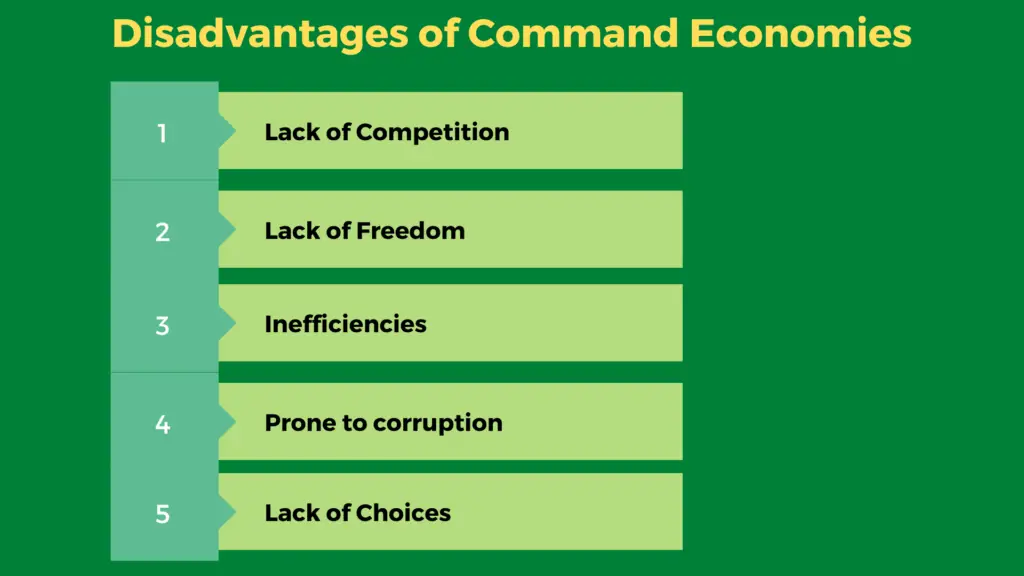Command economies have several drawbacks as well as some benefits. One of the shortcomings of a planned economy is that it can lead to inefficiencies because of a lack of incentives for companies. We will discuss the major command economy disadvantages and their effects.
What is a command economy?
A command economy is also known as a planned economy or centrally planned economy, and it is an economic system wherein the government centrally plans and controls the production and distribution of goods and services in a country. The advantages of a command economy are that it can be very good in its allocation of resources and can produce rapid economic growth. However, there are also several disadvantages to a command economy, which include a lack of competition and innovation, poor quality products, and high levels of corruption.
See also: What is a Free Market Economy? Definition and Examples
Command Economy Disadvantages
- Lack of Economic Freedom
- Inefficiency
- Lack of Incentives
- Lack of Competition
- Lack of Consumer Choice
- Inflexibility and sluggishness in adapting to changes
- Corruption and Cronyism

Lack of Economic Freedom
A common disadvantage of a command economy is a lack of freedom because a command economy tends to exist under a dictatorship or authoritarian government. This means that individuals have very little say in what they can produce, how much they can sell their goods for, or what they can do with their money. This lack of freedom can be stifling for entrepreneurs and other creative people who want to start their own businesses or pursue new ideas. The overall effect is dissatisfied citizens.
As a command economy example, in Cuba, all foreign employers of labor must first pay the government before it pays the workers; this ensures the government has control over how much you get paid no matter how hard you work. In North Korea, houses are built and allocated by the government, a citizen cannot choose where to live, because that will be decided by the government.
All jobs must be aligned with what the government wants for the economy and as such, the citizens have little or no choices at all.
Inefficiency
One of the major disadvantages of a command economy is inefficiency. In a centrally planned economy, the government makes all economic decisions such as telling companies what to produce and the price to sell. The government also decides how to distribute resources. This can cause shortages in the supply of goods and services as the quota of production permitted by the government may not be enough to meet the needs of the people.
You may like: Goals of a Command Economy

For example, the number of trains provided as means of public transport for people may not be enough; it means people have to waste time waiting; the same applies to hospitals, schools, and many other businesses. If restrictions were removed to allow people to start any business they want, then there would have been more buses, more hospitals, and more schools; which will reduce the demand for the ones provided by the government.
Therefore, inefficiency is a common shortcoming of command economies.
Lack of Incentives is a common command economy disadvantage
Because the government controls everything in a command economy, there is little incentive for businesses or individuals to work hard or be innovative. Why bother trying to produce more or better products when the government will just set the price and decide how much to produce? This lack of incentive can lead to low levels of productivity in a planned economy.
Lack of Competition
One of the disadvantages of a command economy is the absence of competition. When businesses are allowed to compete, it drives innovation and increases the quality of products which is beneficial to consumers. However, this is lacking in a centrally planned economy.
This command economy disadvantage has the effect of producing low-quality products because businesses have no reason to improve their products or services or find new ways to produce them.
When compared with other countries practicing a free market economy, a command economy finds it difficult to keep up because competition for profits is the driver of innovations.
Lack of Consumer Choices
A common disadvantage of a command economy is the lack of choices that consumers have; because the government decides which goods and services will be produced and oftentimes only produces those that it deems necessary for the country. If the government decides to provide housing, then all the houses will be the same and you cannot build a house to your standard.
You get to use whatever is produced according to the government’s instructions. This leaves consumers with few or no choices about what to buy since only certain items are available.
Also, since the government sets prices, consumers may not be able to afford what is available and would have no other choice available. This is different from a free market system where other competitors may lower their prices in order to increase their market share or break into a new market.
Inflexibility and sluggishness in adapting to changes
There are many bureaucracies involved in government processes; this can often cause sluggishness in responding to problems or solving issues.
For example, a telecommunication mast may fall and needs to be replaced; if it was a privately owned company with many competitors, it will respond immediately and try to fix the problem within hours to prevent losing customers.
In the case of a command economy, the problem has to be reported to the office, which then has to be given permission to go ahead and fix it, and then funds have to be released to buy the needed items. And even if the government officials fail to fix the problem, their salaries or wages will still be paid and therefore the motivation to move quickly is always low because there is simply no reason to even work since there are no competitors.
Therefore, slow responses to changing consumer demands are problems often encountered in centrally planned economies.
Corruption and cronyism
One of the command economy disadvantages is corruption. Because the government has such a large role in controlling or directing the economy, there is a lot of opportunity for corruption and cronyism. Those in power may set laws that favor themselves, the elites, or friends. This can lead to resentment and social unrest.
See Also: What is one way a command economy affects the lives of private citizens?
Why do command economies fail?
There are many reasons why command economies fail. One reason is that they tend to be very inefficient. This is because the government centrally plans all economic activity, which can lead to a lot of waste and insufficiency. Also, command economies fail because they stifle innovation and creativity as people are not able to pursue their own ideas and start their own businesses. This lack of entrepreneurship can lead to economic stagnation.
Nansel is a serial entrepreneur and financial expert with 7+ years as a business analyst. He has a liking for marketing which he regards as an important part of business success.
He lives in Plateau State, Nigeria with his wife, Joyce, and daughter, Anael.
